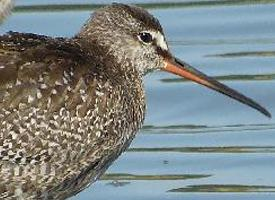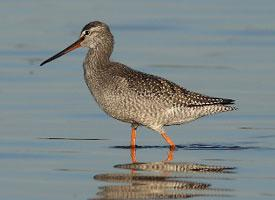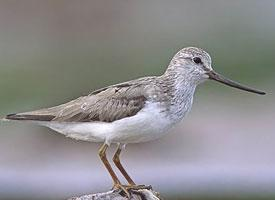
Description de l'animal
The Common Redshank, scientifically known as Tringa totanus, is a captivating species of wading bird that is part of the large family Scolopacidae, which includes sandpipers and allies. This medium-sized bird is easily recognized by its striking appearance and distinctive behaviors, making it a fascinating subject for birdwatchers and nature enthusiasts alike.The Common Redshank stands out with its bright orange-red legs, from which it derives its name. These vibrant legs contrast beautifully with its predominantly grey-brown plumage, which is finely patterned with dark streaks and spots. During the breeding season, the plumage takes on a more pronounced reddish hue, especially on the breast, adding to its allure. The bird's bill is another distinctive feature; it is relatively long, straight, and also colored in a matching orange-red near the base, transitioning to a darker tip.
Measuring about 25 to 30 centimeters in length, with a wingspan that ranges from 50 to 57 centimeters, the Common Redshank is of a size that is typical for waders. Its call, a loud and penetrating 'teu-teu-teu', is often heard before the bird is seen, serving as a warning to others of potential danger.
The habitat of the Common Redshank is as varied as its diet. It is primarily found along coastal areas, estuaries, and wetlands across Europe and Asia, extending its range to parts of Africa and the Middle East during the winter months. This bird exhibits a preference for mudflats, saltmarshes, and shallow waters where it can forage for food. Its diet is omnivorous, consisting of insects, earthworms, small fish, crustaceans, and mollusks, which it skillfully extracts from mud and shallow water with its sensitive bill.
Breeding season brings another layer of intrigue to the life of the Common Redshank. The bird is monogamous, forming long-term pair bonds. Nests are typically built on the ground, hidden among vegetation in wetland areas. Both parents are involved in the incubation of the eggs and the rearing of the young, showcasing a remarkable level of parental care. The nests and surrounding territories are fiercely defended against predators and intruders, with the redshank's loud call serving as a persistent alarm.
In terms of conservation, the Common Redshank is classified as of Least Concern by the International Union for Conservation of Nature (IUCN), although certain populations are experiencing declines due to habitat loss and degradation. Conservation efforts are focused on protecting wetland habitats and ensuring sustainable land use practices to support this species and countless others that rely on similar environments.
In summary, the Common Redshank is a striking and adaptable bird, whose vibrant legs and melodious call make it a memorable sight in its natural wetland habitats. Its presence is a reminder of the intricate connections within ecosystems and the importance of conserving natural habitats for the survival of species.
Animaux similaires
Nouvelles photos d'animaux
Top 10 des animaux
- Dolphin gull (Leucophaeus scoresbii)
- Japanese macaque (Macaca fuscata)
- Stone loach (Barbatula barbatula)
- Greek tortoise (Testudo graeca)
- Russian tortoise (Testudo horsfieldii)
- Galápagos tortoise (Geochelone nigra complex)
- Diana monkey (Cercopithecus diana)
- Moustached guenon (Cercopithecus cephus)
- Common flying dragon (Draco volans)
- Galápagos penguin (Spheniscus mendiculus)


